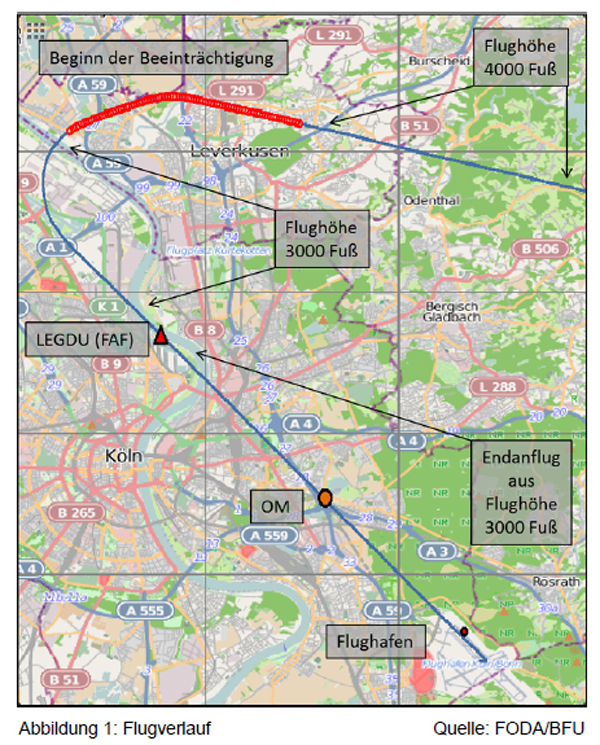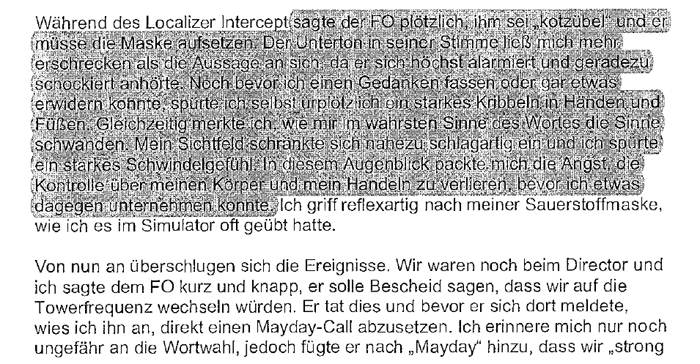
Lufthansa’s subsidiary ‚Germanwings’: December 19, 2010
On this day one of the most dangerous incidents of its kind occurs - at least as far as others have not (yet) become known. Although this incident was reported to the BFU, they initially did not determine it to be an "incident". An investigation wasn't even started, which only happened much later: when the incident surfaced at the German Bundestag.
The events :
Already on approach to Cologne/Bonn airport and about 20km before landing, the 35 year old captain and his 26 year old co-pilot noticed a strange smell: a mixture of a burning and electric smell. The captain thinks about putting on his oxygen mask, but rejects the thought - the "smell event" seems to be diminishing.
However, just then the co-pilot tells the captain that he is feeling "sick". He dons the mask.
At this very moment, the captain's hands and feet begin to tingle, his field of vision is restricted and his "senses are fading" – all the while the Airbus 319 continues its descent. Now panic begins to spread. The captain issues a ‚mayday’ call hoping they'll manage the landing - there are 142 passengers on the Airbus. The jet is now just overhead of the city of Cologne:

In a first reconstruction, which is only made about one year later (see below), the procedures in the cockpit read as follows:
"At this point in time, the co-pilot had difficulties to grasp the process in an overall picture. He could only concentrate with difficulty on selective aspects of what was going on and felt that he could no longer process the current information.
Also the captain had reached the end of his abilities. He felt distracted by the noise of his own breathing in the oxygen mask and found that it disturbed the communication between him and his co-pilot. During the whole approach he felt physically very ill.
On manual flight with the flight command system (flight director) he was working at the upper limit of what seemed possible to himself ".
What the two pilots themselves wrote in their flight reports and how they were able to bring the Airbus down, albeit with a hard landing, as follows.
In this picture is a small excerpt. Clicking on the text opens the two complete reports as PDF:
They landed with fire brigades and ambulances already waiting on the tarmac. The captain and co-pilot have to go to hospital. The captain can fly again four days later, the co-pilot is "not fit to fly" for six months.
Only the employer's liability insurance association (BG) registers the incident as an accident - the airline reports the incident because the co-pilot is absent for half a year. Lufthansa’s subsidiary Germanwings, which has to continue paying the salaries for the first few weeks, then, wants to get money back from "BG Verkehr“.
The German BFU receives a message from the police via fax.
The further handling of this near-accident is revealing:
It will only get underway a little less than a year later when journalist and film maker Tim van BEVEREN addresses this case at a hearing in the Bundestag's ‚Tourism Committee’ in September 2011. This committee is not public. At least some members of the Bundestag are now aware that the airlines and the responsible BFU (Bundesanstalt für Flugunfalluntersuchungen) apparently do not take the mandatory reporting too seriously. At least not across the board.
Only after that the BFU begins activity. They'll produce two reports:
- In the interim report, the cause is found to be "highly likely to have originated from de-icing fluid“; oil, fuel or electrical odors were definitely excluded by the technicians.
The German Federal Aviation Authority (LBA) representative, who was present at the hearing in the Tourism Committee a year earlier, rightly commented that this assumption was "nonsense" to the members of parliament: an aircraft that has been in the air for over one hour and is approaching an airport has no residues of de-icing fluid left anywhere. - The BFU must make a little more effort for their final report. It now leaves the assessment up to the Air Force Aviation Medical Institute.
The " ... symptoms described above could be compatible with the inhibition of the enzyme acetylcholinesterase or other neurospecific esterases caused by organophosphate compounds, in particular tricresyl phosphate and its isomers, without knowledge of the overall situation". ... (S. 32). So: Aerotoxic Syndrome!
" ...in terms of differential diagnosis" (p. 34), however, other causes could also be considered...“ , which the BFU then ultimately sums up in this way:
"The health impairments of the cockpit crew during the landing approach, combined with a significant reduction in the performance of both pilots, were very likely due to the following: a massive development of odours in the cockpit area, the origin and distribution of which could not be determined.
What could have contributed: physiological and psychological effects of the odours on both crew members."
In other words: The co-pilot had over-exerted himself during sport activities before the flight and the captain had succumbed to the so-called nocebo effect. The latter means (in contrast to the placebo effect) that health problems can be caused by imagining them.
Aerotoxic Syndrome is also explained as a ‚nocebo effect’ in the English part of WIKIPEDIA. Albeit, in a rather different context under The presentation of the problem of contaminated cabin air in WIKIPEDIA.
The co-pilot, who was unable to fly for six months has not yet been allowed to view the medical report of the Air Force Aviation Medical Institute.
(JL)
Update::
We asked the BFU why the person concerned should not know what came out of it? Response of the Federal Office for Aircraft Accident Investigation (BFU) 26th April 2018:
"An inspection of the ... expert opinion cannot be granted due to the protection of sensitive security information to be guaranteed according to Art 14 Regulation (EU) 996/2010".
Online am: 28.07.2018
Aktualisiert am: 10.08.2018
Inhalt:
- Fume Events Worldwide
- What is different when we fly at 10 km altitude?
- Contaminated cabin air: a health problem becomes certainty. The chronology of the socalled Aerotoxic Syndrome
- "Incidents": Incidents that do not usually appear in official statistics
- Lufthansa’s subsidiary ‚Germanwings’: December 19, 2010
- Health, Science and Economic interests in Aerotoxic Syndrome
- An UNCOVERING of Tricks, Methods and Strategies, how to downplay fume events
- 1 Reviewer - 2 Opinions: Prof. Dr. Stephan LETZEL
- Occupational Medicine in Germany: "Misleading Representation"?
- Tim van BEVEREN and the WDR documentary "Nervengift im Flugzeug" (Nerve Poison in Aircraft“): Chronicle of a film making, which turned into 2 (different) documentaries
- What Can You Do ?
Tags:

